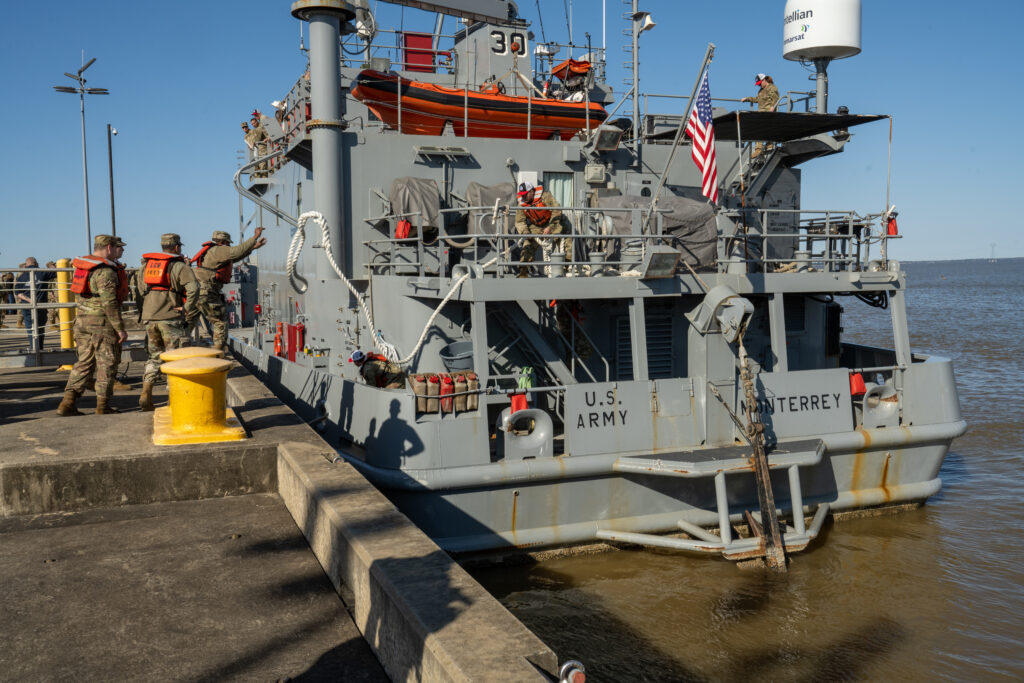
March 12, 2024 | By Joseph Clark
The specialized Army unit tasked with establishing a temporary pier off the coast of Gaza to deliver critical humanitarian assistance has wasted no time in making the complex operation a reality.
The first of several watercraft used to construct the pier and manned by troops from the 7th Transportation Brigade began the weekslong transit from the unit’s homeport in Virginia to the U.S. Central Command area of responsibility less than two days after President Joe Biden called on the military to conduct the emergency operation during his State of the Union Address.
Today, four more Army vessels set sail from Joint Base Langley-Eustis to join the operation: USAVs Monterrey, Matamoros, SP4 James A. Loux and Wilson Wharf.
The brigade, a component of the XVIII Airborne Corps, is the Army’s premier watercraft unit specializing in Joint Logistics Over-the-Shore, or JLOTS.
JLOTS systems can jointly employ Army and Navy logistics assets to deliver critical supplies to troops or civilians in austere environments anywhere in the world.
“This is Army watercraft’s moment, and we’re up for it,” said Army Col. Samuel S. Miller, the 7th Transportation Brigade (Expeditionary) commander.
“The U.S. and the world will see our humanitarian capability on display and in action forward,” he said. “The 7th TB(X) is highly trained, mobile, versatile and capable to operate in these types of environments.”
Delivering the capability involves the complex choreography of logistics support and landing craft vessels that carry the equipment used to construct an approximately 1,800-foot causeway comprised of modular sections linked together known as a Trident Pier.
Once in theater, the unit will begin construction of the causeway off the coast of Gaza enabling the flow of critical aid from the sea to civilians affected by the ongoing conflict. The capability is expected to be operational in approximately 60 days.
Deploying on short notice anywhere throughout the globe is par for course for the units that comprise the XVIII Airborne Corps, said Army Brig. Gen. John B. Hinson, the corps’ assistant commanding general for support.
“We are the contingency corps for the Army,” Hinson said. “We have units, divisions, brigade combat teams, separate brigades, that can deploy anywhere in the world for any type of contingency operation in 18 hours.
“The 7th TB(X) is one of these units that falls in that category where all of their units are very deployable for an immediate response force for different types of contingencies all around the world,” he said.
Once operational, the pier will be capable of delivering up to 2,000,000 humanitarian aid meals per day.
Pentagon Press Secretary Maj. Gen. Pat Ryder previewed the capability Friday during a briefing at the Pentagon following Biden’s State of the Union Address.
“This is part of a full-court press by the United States to not only focus on working on opening up and expanding routes via land, which are the optimal way to get aid into Gaza but also by conducting air drops,” Ryder said.
The U.S. has conducted several humanitarian assistance airdrops into Gaza alongside the Royal Jordanian Air Force. The combined operations have delivered hundreds of thousands of badly needed meals to civilians.
Biden said more aid is needed.
Ryder stressed that the JLOTS capability enables the U.S. to continue delivering aid without putting boots on the ground in Gaza.
“We’ll be working with partners in the region to be on the receiving end of , but at no time will we require U.S. forces to actually go on the ground,” he said. “Our role will be essentially to provide the service of getting to the causeway, at which point it will then be distributed.”
Miller said the unit’s extensive training in environments throughout the world has prepared its soldiers to accomplish the mission in Gaza.
JLOTS was last used operationally to deliver humanitarian assistance following the magnitude 7.0 earthquake that struck Haiti in 2010.
Soldiers from the 7th TB(X) train extensively in deploying the capability around the globe, including off the coast of Australia last summer in support of Exercise Talisman Sabre, a large-scale joint defense exercise between Australia and the United States.
“We understand the importance of this mission, and the interests of the world in this regard,” Miller said. “When it may seem, at times, we have the weight of the world on our shoulders, we will forge across the water to deliver humanitarian assistance.”
That same determination was echoed throughout the ranks.
“We like what we do,” said Army Chief Warrant Officer 3 Benjamin Tate, the chief engineer on one of the vessels that set sail for Gaza today.
“We’re extremely proud that we get to participate in humanitarian relief,” Tate said. “Me personally, if my family was in that situation, I’d want somebody to be willing to help. So, when we were told that was the task, our guys are ramping the boat up and getting ready.”
- SECNAV Del Toro Names Future Nuclear-Powered Attack Submarine USS Miami with Gloria Estefan as Sponsor - May 8, 2024
- U.S. Navy Accepts Delivery of USNS Earl Warren - May 8, 2024
- May 7 Central Command Update - May 8, 2024



